Comparative Transcriptome Analysis Reveals Genetic Mechanisms of Sugarcane Aphid Resistance in Grain Sorghum
Abstract
1. Introduction
2. Results
2.1. RNA-Seq Data Summary
2.2. Differentially Expressed Genes (DEGs)
2.3. Dynamics of Differential Gene Expression in Response to SCA Infestation
2.4. Identification of Commonalities and Differences of DEGs
2.5. Annotation and Clustering of Expressed Genes
2.6. Gene Ontology Enrichment of DEGs
2.7. Transcription Factor Expression in Response to SCA Infestation
3. Discussion
4. Materials and Methods
4.1. Plant Materials
4.2. Aphid Infestation and Sampling
4.3. RNA Extraction, Library Construction and Sequencing
4.4. RNA-Seq Analysis
4.5. Gene Ontology Enrichment and Clustering Analyses
5. Conclusions
Supplementary Materials
Author Contributions
Funding
Institutional Review Board Statement
Informed Consent Statement
Data Availability Statement
Acknowledgments
Conflicts of Interest
References
- FAOSTAT. United Nations Food and Agriculture Organization Statistics. 2018. Available online: http://www.fao.org/faostat/en/#home (accessed on 23 October 2020).
- Ciampitti, I.A.; Prasad, P.V.V. Sorghum: State of the Art and Future Perspective; Monograph 58; American Society of Agronomy: Madison, WI, USA, 2019. [Google Scholar] [CrossRef]
- Balakrishna, D.; Singode, A.; Bhat, B.V.; Tonapi, V.A. Sorghum Improvement Through Efficient Breeding Technologies. In Accelerated Plant Breeding, Volume 1: Cereal Crops; Gosal, S.S., Wani, S.H., Eds.; Springer International Publishing: Cham, Switzerland, 2020; pp. 411–435. [Google Scholar]
- Villanueva, R.T.; Brewer, M.J.; Way, M.O.; Biles, S.; Sekula, D.; Bynum, E.; Swart, J.; Crumley, C.; Knutson, A.; Poter, P.; et al. Sugarcane Aphid: A New Pest of Sorghum; Texas A&M AgriLife Extension. ENTO-35; Burleigh Dodds Science Publishing: College Station, TX, USA, 2014. [Google Scholar]
- Brewer, M.J.; Bowling, R.; Michaud, J.P.; Jacobson, A.L. Sugarcane Aphid: A New Sorghum Pest in North America; Texas A&M AgriLife Extension. ENTO-056; Burleigh Dodds Science Publishing: College Station, TX, USA, 2016. [Google Scholar]
- Paterson, A.H. Genomics of sorghum. Int. J. Plant Genom. 2008, 2008, 362451. [Google Scholar] [CrossRef]
- Paterson, A.H.; Bowers, J.E.; Bruggmann, R.; Dubchak, I.; Grimwood, J.; Gundlach, H.; Haberer, G.; Hellsten, U.; Mitros, T.; Poliakov, A.; et al. The Sorghum bicolor genome and the diversification of grasses. Nature 2009, 457, 551–556. [Google Scholar] [CrossRef] [PubMed]
- Cooper, E.A.; Brenton, Z.W.; Flinn, B.S.; Jenkins, J.; Shu, S.; Flowers, D.; Luo, F.; Wang, Y.; Xia, P.; Barry, K.; et al. A new reference genome for Sorghum bicolor reveals high levels of sequence similarity between sweet and grain genotypes: Implications for the genetics of sugar metabolism. BMC Genom. 2019, 20, 1–13. [Google Scholar] [CrossRef]
- Mead, F.W. Sugarcane aphid, Melanaphis Sacchari (Zehntner); New Continental United States Record. Coop Plant Pest Rep. 1978, 3, 475. [Google Scholar]
- White, W.H.; Reagan, T.E.; Hall, D.G. Melanaphis sacchari, a new pest of sugarcane in Louisiana. Fla. Entomol. 2001, 84, 435–436. [Google Scholar] [CrossRef]
- Armstrong, J.S.; Rooney, W.L.; Peterson, G.C.; Villenueva, R.T.; Brewer, M.J.; Sekula-Ortiz, D. Sugarcane aphid (Hemiptera: Aphididae): Host range and sorghum resistance including cross-resistance from greenbug sources. J. Econ. Entomol. 2015, 108, 576–582. [Google Scholar] [CrossRef]
- Bowling, R.D.; Brewer, M.J.; Kerns, D.L.; Gordy, J.; Seiter, N.; Elliott, N.E.; Buntin, G.D.; Way, M.O.; Royer, T.A.; Biles, S.; et al. Sugarcane Aphid (Hemiptera: Aphididae): A new pest on sorghum in North America. J. Integr. Pest Manag. 2016, 7, 12. [Google Scholar] [CrossRef]
- Kiani, M.; Szczepaniec, A. Effects of sugarcane aphid herbivory on transcriptional responses of resistant and susceptible sorghum. BMC Genom. 2018, 19, 774. [Google Scholar] [CrossRef] [PubMed]
- Zapata, S.; Dudensing, R.; Sekula, D.; Esparza-Diaz, G.; Villanueva, R. Estimating the Economic Impact of Invasive Pests: The Case of the Sugarcane Aphid Outbreak. In Proceedings of the Agricultural and Applied Economics Association: No 258441, Annual Meeting, Chicago, IL, USA, 30 July–1 August 2017. [Google Scholar]
- Koralewski, T.E.; Wang, H.-H.; Grant, W.E.; Brewer, M.J.; Elliott, N.C.; Westbrook, J.K.; Szczepaniec, A.; Knutson, A.; Giles, K.L.; Michaud, J.P. Integrating Models of Atmospheric Dispersion and Crop-Pest Dynamics: Linking Detection of Local Aphid Infestations to Forecasts of Region-Wide Invasion of Cereal Crops. Ann. Entomol. Soc. Am. 2020, 113, 79–87. [Google Scholar] [CrossRef]
- Armstrong, J.S.; Mbulwe, L.; Sekula-Ortiz, D.; Villanueva, R.T.; Rooney, W.L. Resistance to Melanaphis sacchari (Hemiptera: Aphididae) in forage and grain sorghums. J. Econ. Entomol. 2017, 110, 259–265. [Google Scholar] [CrossRef][Green Version]
- Bayoumy, M.H.; Perumal, R.; Michaud, J.P. Comparative life histories of greenbugs and sugarcane aphids (Hemiptera: Aphididae) coinfesting susceptible and resistant sorghums. J. Econ. Entomol. 2016, 109, 385–391. [Google Scholar] [CrossRef]
- Souza, M.; Armstrong, J.; Hoback, W.; Mulder, P.; Paudyal, S.; Foster, J.E.; Payton, M.E.; Akosa, J. Temperature dependent development of sugarcane aphids Melanaphis Sacchari, (Hemiptera: Aphididae) on three different host plants with estimates of the lower and upper threshold for fecundity. Curr. Trends Entomol. Zool. Stds. 2019, 2, 1011. [Google Scholar] [CrossRef]
- Colares, F.; Michaud, J.P.; Bain, C.L.; Torres, J.B. Recruitment of aphidophagous arthropods to sorghum plants infested with Melanaphis sacchari and Schizaphis graminum (Hemiptera: Aphididae). Biol. Control 2015, 90, 16–24. [Google Scholar] [CrossRef]
- Colares, F.; Michaud, J.P.; Bain, C.L.; Torres, J. Indigenous aphid predators show high levels of preadaptation to a novel prey, Melanaphis sacchari (Hemiptera: Aphididae). J. Econ. Entomol. 2015, 108, 2546–2555. [Google Scholar] [CrossRef]
- Bostick, N.M.; Laforest, J.H.; Bargeron, C.T.; Culbreath, A.K.; Brenneman, T.B.; Schmidt, J.M.; Buntin, G.D.; Toews, M.D. Assessment of consensus-based scouting for management of sugarcane aphid (Heteroptera: Aphididae) in Georgia. J. Entomol. Sci. 2020, 55, 1. [Google Scholar] [CrossRef]
- Schuster, D.J.; Starks, K.J. Greenbugs: Components of host-plant resistance in sorghum123. J. Econ. Entomol. 1973, 66, 1131–1134. [Google Scholar] [CrossRef]
- Dixon, A.G.O.; Bramel-Cox, P.J.; Harvey, T.L. Complementarity of genes for resistance to greenbug [Schizaphis graminum (Rondani)], biotype E, in sorghum [Sorghum bicolor (L.) Moench]. Theor. Appl. Genet. 1991, 81, 105–110. [Google Scholar] [CrossRef]
- Michoud, J.P. IPM case studies: Sorghum. In Aphids as Crop Pests, 2nd ed.; van Emden, H.F., Ed.; CABI Bioscience: Oxfordshire, UK, 2017; pp. 557–568. [Google Scholar]
- Mbulwe, L.; Peterson, G.C.; Scott-Armstrong, J.; Rooney, W.L. Registration of sorghum germplasm Tx3408 and Tx3409 with tolerance to sugarcane Aphid [Melanaphis sacchari (Zehntner)]. J. Plant Regist. 2016, 10, 51–56. [Google Scholar] [CrossRef]
- War, A.R.; Paulraj, M.G.; Ahmad, T.; Buhroo, A.A.; Hussain, B.; Ignacimuthu, S.; Sharma, H.C. Mechanisms of plant defense against insect herbivores. Plant Signal. Behav. 2012, 7, 1306–1320. [Google Scholar] [CrossRef]
- Karban, R. The ecology and evolution of induced responses to herbivory and how plants perceive risk. Ecol. Entomol. 2020, 45, 1–9. [Google Scholar] [CrossRef]
- Louis, J.; Shah, J. Arabidopsis thaliana—Myzus persicae interaction: Shaping the understanding of plant defense against phloem-feeding aphids. Front. Plant Sci. 2013, 4, 213. Available online: https://www.frontiersin.org/article/10.3389/fpls.2013.00213 (accessed on 23 October 2020). [CrossRef]
- Sharma, H.C.; Bhagwat, V.R.; Daware, D.G.; Pawar, D.B.; Munghate, R.S.; Sharma, S.P.; Kumar, A.A.; Reddy, B.V.S.; Prabhakar, K.B.; Ambekar, S.S.; et al. Identification of sorghum genotypes with resistance to the sugarcane aphid Melanaphis sacchari under natural and artificial infestation. Plant Breed. 2014, 133, 36–44. [Google Scholar] [CrossRef]
- Liu, F.-H.; Kang, Z.-W.; Tan, X.-L.; Fan, Y.-L.; Tian, H.-G.; Liu, T.-X. Physiology and defense responses of wheat to the infestation of different cereal aphids. J. Integr. Agric. 2020, 19, 1464–1474. [Google Scholar] [CrossRef]
- Tetreault, H.M.; Grover, S.; Scully, E.D.; Gries, T.; Palmer, N.A.; Sarath, G.; Louis, J.; Sattler, S.E. Global responses of resistant and susceptible sorghum (Sorghum bicolor) to Sugarcane Aphid (Melanaphis sacchari). Front. Plant Sci. 2019, 10, 145. Available online: https://www.frontiersin.org/article/10.3389/fpls.2019.00145 (accessed on 23 October 2020). [CrossRef] [PubMed]
- Miles, P.W. Aphid saliva. Biol. Rev. 1999, 74, 41–85. [Google Scholar] [CrossRef]
- Pegadaraju, V.; Louis, J.; Singh, V.; Reese, J.C.; Bautor, J.; Feys, B.J.; Cook, G.; Parker, J.E.; Shah, J. Phloem-based resistance to green peach aphid is controlled by Arabidopsis PHYTOALEXIN DEFICIENT4 without its signaling partner ENHANCED DISEASE SUSCEPTIBILITY1. Plant J. 2007, 52, 332–341. [Google Scholar] [CrossRef] [PubMed]
- Escudero-Martinez, C.; Leybourne, D.J.; Bos, J.I.B. Plant resistance in different cell layers affects aphid probing and feeding behaviour during non-host and poor-host interactions. Bull. Entomol. Res. 2021, 111, 31–38. [Google Scholar] [CrossRef]
- Zhou, S.; Lou, Y.-R.; Tzin, V.; Jander, G. Alteration of plant primary metabolism in response to insect herbivory. Plant Physiol. 2015, 169, 1488–1498. [Google Scholar] [CrossRef]
- Rogers, L.D.; Overall, C.M. Proteolytic post-translational modification of proteins: Proteomic tools and methodology. Mol. Cell. Proteom. 2013, 12, 3532–3542. [Google Scholar] [CrossRef] [PubMed]
- Friso, G.; van Wijk, K.J. Posttranslational protein modifications in plant metabolism. Plant Physiol. 2015, 169, 1469–1487. [Google Scholar] [CrossRef]
- van Damme, E.J.M. Plant Lectins as Part of the Plant Defense System Against Insects BT—Induced Plant Resistance to Herbivory; Schaller, A., Ed.; Springer: Dordrecht, The Netherlands, 2008; pp. 285–307. [Google Scholar]
- Rahbé, Y.; Sauvion, N.; Febvay, G.; Peumans, W.J.; Gatehouse, A.M.R. Toxicity of lectins and processing of ingested proteins in the pea aphid Acyrthosiphon pisum. Entomol. Exp. Appl. 1995, 76, 143–155. [Google Scholar] [CrossRef]
- Hettenhausen, C.; Schuman, M.C.; Wu, J. MAPK signaling: A key element in plant defense response to insects. Insect Sci. 2015, 22, 157–164. [Google Scholar] [CrossRef]
- Latchman, D.S. Transcription factors: An overview. Int. J. Exp. Pathol. 1993, 74, 417–422. Available online: https://pubmed.ncbi.nlm.nih.gov/8217775 (accessed on 23 October 2020). [CrossRef]
- Kariyat, R.R.; Gaffoor, I.; Sattar, S.; Dixon, C.W.; Frock, N.; Moen, J.; De Moraes, C.M.; Mescher, M.C.; Thompson, G.A.; Chopra, S. Sorghum 3-deoxyanthocyanidin flavonoids confer resistance against corn leaf aphid. J. Chem. Ecol. 2019, 45, 502–514. [Google Scholar] [CrossRef]
- Wu, T.D.; Reeder, J.; Lawrence, M.; Becker, G.; Brauer, M.J. GMAP and GSNAP for genomic sequence alignment: Enhancements to speed, accuracy, and functionality. In Statistical Genomics: Methods and Protocols; Mathé, E., Davis, S., Eds.; Springer: New York, NY, USA, 2016; pp. 283–334. [Google Scholar]
- Rawat, N. Plant defense gene regulation and transcription factor dynamics. Rice Res. Open Access 2016, 4, 2–4. [Google Scholar] [CrossRef]
- Zheng, Z.; Qamar, S.A.; Chen, Z.; Mengiste, T. Arabidopsis WRKY33 transcription factor is required for resistance to necrotrophic fungal pathogens. Plant J. 2006, 48, 592–605. [Google Scholar] [CrossRef] [PubMed]
- Li, Q.; Xie, Q.-G.; Smith-Becker, J.; Navarre, D.A.; Kaloshian, I. Mi-1-Mediated aphid resistance involves salicylic acid and mitogen-activated protein kinase signaling cascades. Mol. Plant. Microbe. Interact. 2006, 19, 655–664. [Google Scholar] [CrossRef]
- Yates-Stewart, A.D.; Pekarcik, A.; Michel, A.; Blakeslee, J.J. Jasmonic acid-isoleucine (JA-Ile) is involved in the host-plant resistance mechanism against the soybean aphid (Hemiptera: Aphididae). J. Econ. Entomol. 2020, 113, 2972–2978. [Google Scholar] [CrossRef]
- Yates-Stewart, A.D.; Daron, J.; Wijeratne, S.; Shahid, S.; Edgington, H.A.; Slotkin, R.K.; Michel, A. Soybean aphids adapted to host-plant resistance by down regulating putative effectors and up regulating transposable elements. Insect Biochem. Mol. Biol. 2020, 121, 103363. [Google Scholar] [CrossRef] [PubMed]
- Florencio-Ortiz, V.; Sellés-Marchart, S.; Casas, J.L. Proteome changes in pepper (Capsicum annuum L.) leaves induced by the green peach aphid (Myzus persicae Sulzer). BMC Plant Biol. 2021, 21, 12. [Google Scholar] [CrossRef] [PubMed]
- Wang, Z.; Dane, F. NAC (NAM/ATAF/CUC) transcription factors in different stresses and their signaling pathway. Acta Physiol. Plant. 2013, 35, 1397–1408. [Google Scholar] [CrossRef]
- Yuan, X.; Wang, H.; Cai, J.; Li, D.; Song, F. NAC transcription factors in plant immunity. Phytopathol. Res. 2019, 1, 3. [Google Scholar] [CrossRef]
- Castelán-Muñoz, N.; Herrera, J.; Cajero-Sánchez, W.; Arrizubieta, M.; Trejo, C.; García-Ponce, B.; Sánchez, M.D.L.P.; Álvarez-Buylla, E.R.; Garay-Arroyo, A. MADS-Box genes are key components of genetic regulatory networks involved in abiotic stress and plastic developmental responses in plants. Front. Plant Sci. 2019, 10, 853. Available online: https://www.frontiersin.org/article/10.3389/fpls.2019.00853 (accessed on 23 October 2020). [CrossRef] [PubMed]
- Fatima, M.; Zhang, X.; Lin, J.; Zhou, P.; Zhou, D.; Ming, R. Expression profiling of MADS-box gene family revealed its role in vegetative development and stem ripening in S. spontaneum. Sci. Rep. 2020, 10, 20536. [Google Scholar] [CrossRef]
- Vitiello, A.; Molisso, D.; Digilio, M.C.; Giorgini, M.; Corrado, G.; Bruce, T.J.A.; D’Agostino, N.; Rao, R. Zucchini plants alter gene expression and emission of (E)-β-caryophyllene following Aphis gossypii infestation. Front. Plant Sci. 2021, 11, 592603. [Google Scholar] [CrossRef]
- Ambawat, S.; Sharma, P.; Yadav, N.R.; Yadav, R.C. MYB transcription factor genes as regulators for plant responses: An overview. Physiol. Mol. Biol. Plants 2013, 19, 307–321. [Google Scholar] [CrossRef] [PubMed]
- Cao, Y.; Li, K.; Li, Y.; Zhao, X.; Wang, L. MYB transcription factors as regulators of secondary metabolism in plants. Biology 2020, 9, 61. [Google Scholar] [CrossRef]
- Welner, D.H.; Deeba, F.; Leggio, L.L.; Skriver, K. Chapter 13—NAC Transcription Factors: From Structure to Function in Stress-Associated Networks; Gonzalez, D.H., Ed.; Academic Press: Boston, MA, USA, 2016; pp. 199–212. [Google Scholar]
- Shao, H.; Wang, H.; Tang, X. NAC transcription factors in plant multiple abiotic stress responses: Progress and prospects. Front. Plant Sci. 2015, 6, 902. [Google Scholar] [CrossRef] [PubMed]
- Ramsay, N.A.; Glover, B.J. MYB–bHLH–WD40 protein complex and the evolution of cellular diversity. Trends Plant Sci. 2005, 10, 63–70. [Google Scholar] [CrossRef] [PubMed]
- Tu, X.; Mejía-Guerra, M.K.; Valdes Franco, J.A.; Tzeng, D.; Chu, P.Y.; Shen, W.; Wei, Y.; Dai, X.; Li, P.; Buckler, E.S.; et al. Reconstructing the maize leaf regulatory network using ChIP-seq data of 104 transcription factors. Nat. Commun. 2020, 11, 1–13. [Google Scholar] [CrossRef]
- Anathakrishnan, R.; Sinha, D.K.; Murugan, M.; Zhu, K.Y.; Chen, M.S.; Zhu, Y.C.; Smith, C.M. Comparative gut transcriptome analysis reveals differences between virulent and avirulent Russian wheat aphids, Diuraphis noxia. Arthropod. Plant. Interact. 2014, 8, 79–88. [Google Scholar] [CrossRef][Green Version]
- Lan, H.; Zhang, Z.-F.; Wu, J.; Cao, H.-H.; Liu, T.-X. Performance and transcriptomic response of the English grain aphid, Sitobion avenae, feeding on resistant and susceptible wheat cultivars. J. Integr. Agric. 2021, 20, 178–190. [Google Scholar] [CrossRef]
- The International Aphid Genomics Consortium. Correction: Genome Sequence of the Pea Aphid Acyrthosiphon pisum. PLoS Biol. 2018, 16, e3000029. [Google Scholar] [CrossRef]
- Stern, D.L. Aphids. Curr. Biol. 2008, 18, 504–505. [Google Scholar] [CrossRef] [PubMed]
- Teetes, G.L.; Manthe, C.S.; Peterson, G.C.; Leuschner, K.; Pendleton, B.B. Sorghum resistant to the sugarcane aphid, Melanaphis sacchari (Homoptera: Aphididae), in Botswana and Zimbabwe. Insect Sci. Appl. 1995, 16, 63–71. [Google Scholar] [CrossRef]
- Johnson, J.W.; Rosenow, D.T.; Teetes, G.L.; Phillips, J.M. Registration of 19 greenbug resistant sorghum germplasm lines. Crop Sci. 1982, 22, 1272. [Google Scholar] [CrossRef]
- Iqbal, Z.; Iqbal, M.S.; Hashem, A.; Abd_Allah, E.F.; Ansari, M.I. Plant defense responses to biotic stress and its interplay with fluctuating dark/light conditions. Front. Plant Sci. 2021, 12, 297. [Google Scholar] [CrossRef]
- Bolger, A.M.; Lohse, M.; Usadel, B. Trimmomatic: A flexible trimmer for Illumina sequence data. Bioinformatics 2014, 30, 2114–2120. [Google Scholar] [CrossRef] [PubMed]
- McCormick, R.F.; Truong, S.K.; Sreedasyam, A.; Jenkins, J.; Shu, S.; Sims, D.; Kennedy, M.; Amirebrahimi, M.; Weers, B.D.; McKinley, B.; et al. The Sorghum bicolor reference genome: Improved assembly, gene annotations, a transcriptome atlas, and signatures of genome organization. Plant J. 2018, 93, 338–354. [Google Scholar] [CrossRef]
- Li, H.; Handsaker, B.; Wysoker, A.; Fennell, T.; Ruan, J.; Homer, N.; Marth, G.; Abecasis, G.; Durbin, R. 1000 Genome Project Data Processing Subgroup. The sequence alignment/map format and SAMtools. Bioinformatics 2009, 25, 2078–2079. [Google Scholar] [CrossRef]
- Trapnell, C.; Williams, B.; Pertea, G.; Mortazavi, A.; Kwan, G.; Van Baren, M.J.; Salzberg, S.; Wold, B.J.; Pachter, L. Transcript assembly and quantification by RNA-Seq reveals unannotated transcripts and isoform switching during cell differentiation. Nat. Biotechnol. 2010, 28, 511–515. [Google Scholar] [CrossRef] [PubMed]
- Sartor, R.C.; Noshay, J.; Springer, N.M.; Briggs, S.P. Identification of the expressome by machine learning on omics data. Proc. Natl. Acad. Sci. USA 2019, 116, 18119–18125. [Google Scholar] [CrossRef]
- Anders, S.; Pyl, P.T.; Huber, W. HTSeq-a Python framework to work with high-throughput sequencing data. Bioinformatics 2015, 31, 166–169. [Google Scholar] [CrossRef] [PubMed]
- Love, M.I.; Huber, W.; Anders, S. Moderated estimation of fold change and dispersion for RNA-seq data with DESeq2. Genome Biol. 2014, 15. [Google Scholar] [CrossRef]
- Klopfenstein, D.V.; Zhang, L.; Pedersen, B.S.; Ramírez, F.; Vesztrocy, A.W.; Naldi, A.; Mungall, C.J.; Yunes, J.M.; Botvinnik, O.; Weigel, M.; et al. GOATOOLS: A Python library for Gene Ontology analyses. Sci. Rep. 2018, 8, 1–17. [Google Scholar] [CrossRef]
- Tian, T.; Liu, Y.; Yan, H.; You, Q.; Yi, X.; Du, Z.; Xu, W.; Su, Z. agriGO v2.0: A GO analysis toolkit for the agricultural community, 2017 update. Nucleic Acids Res. 2017, 45, W122–W129. [Google Scholar] [CrossRef] [PubMed]

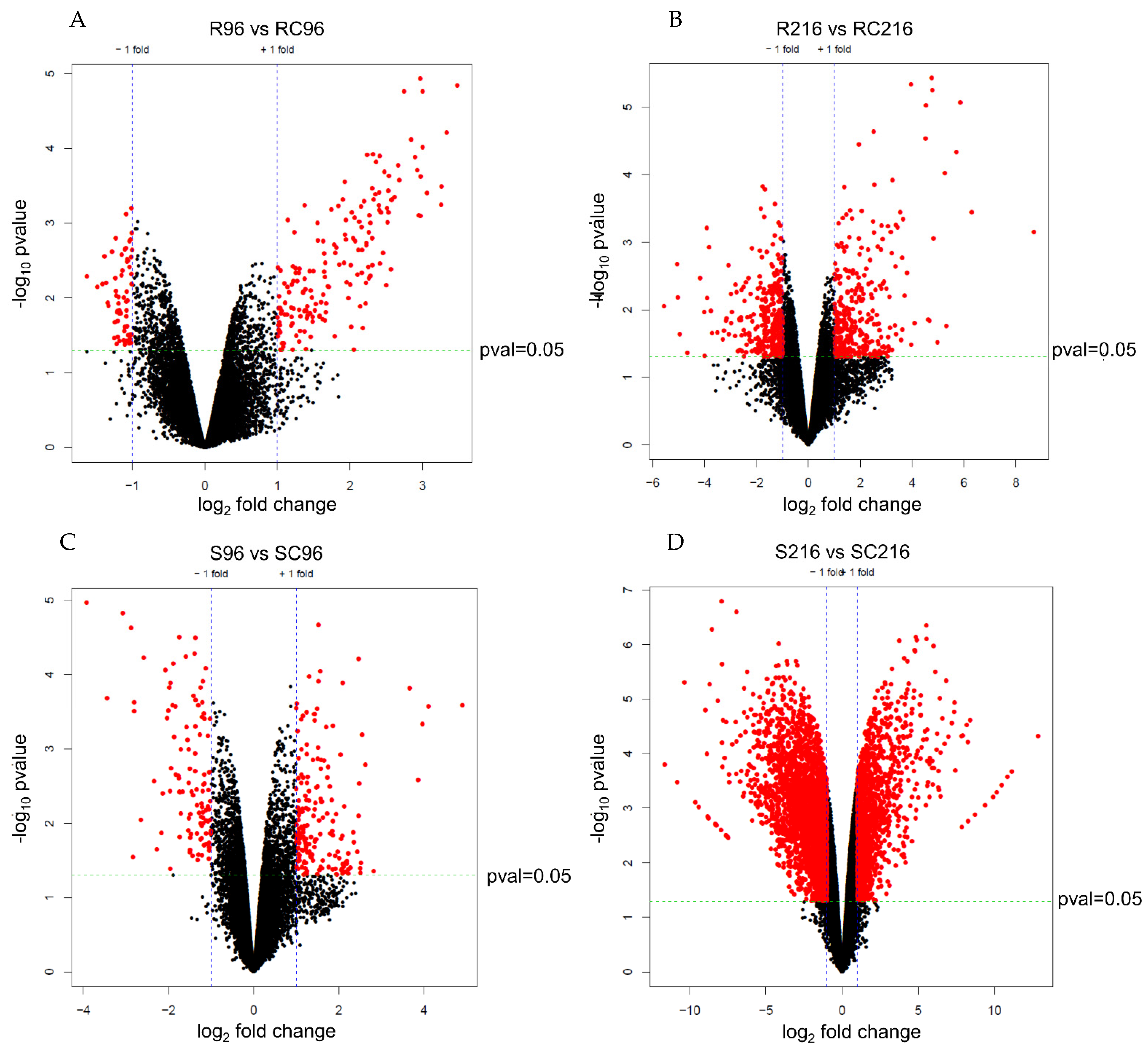
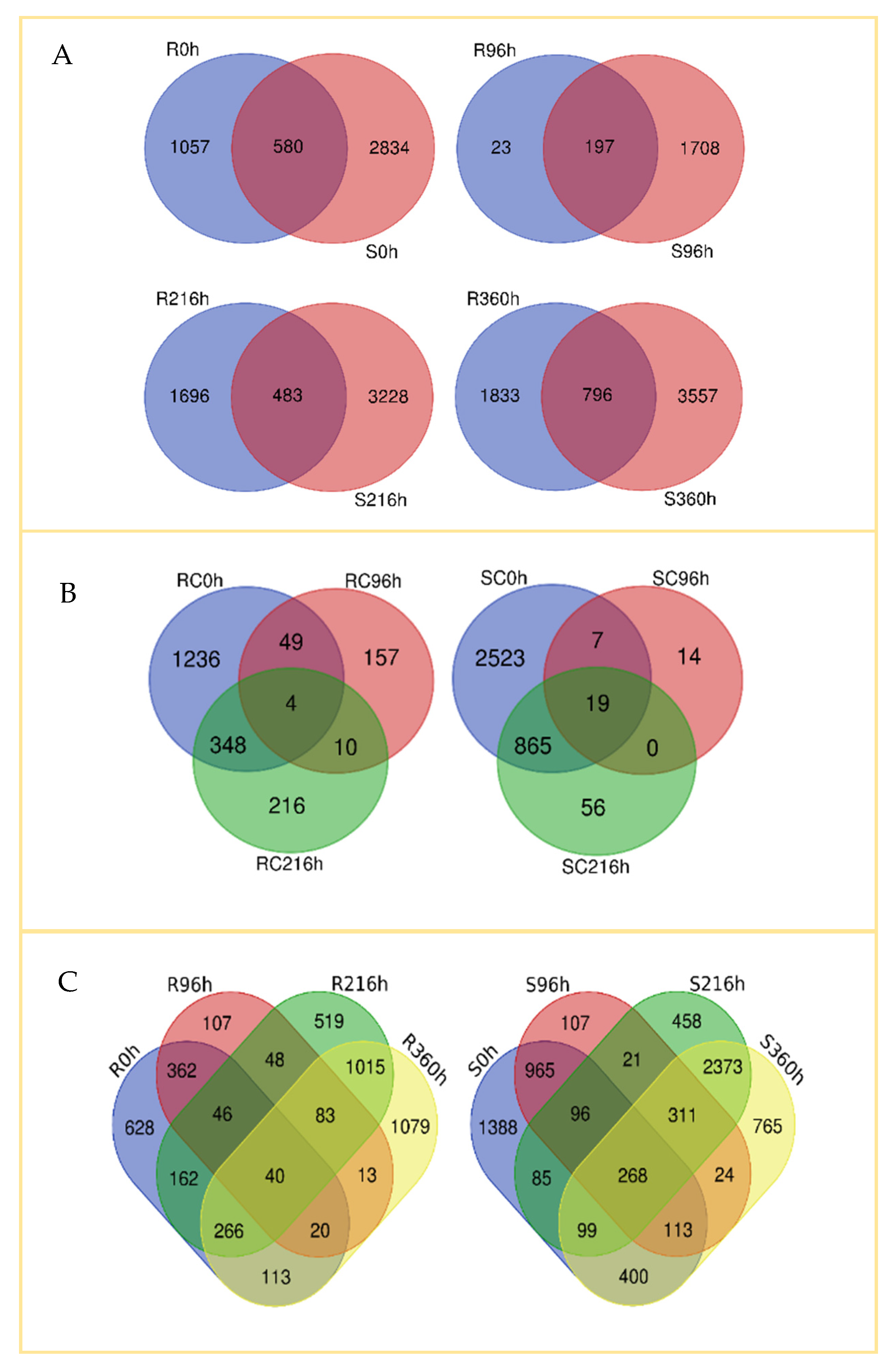
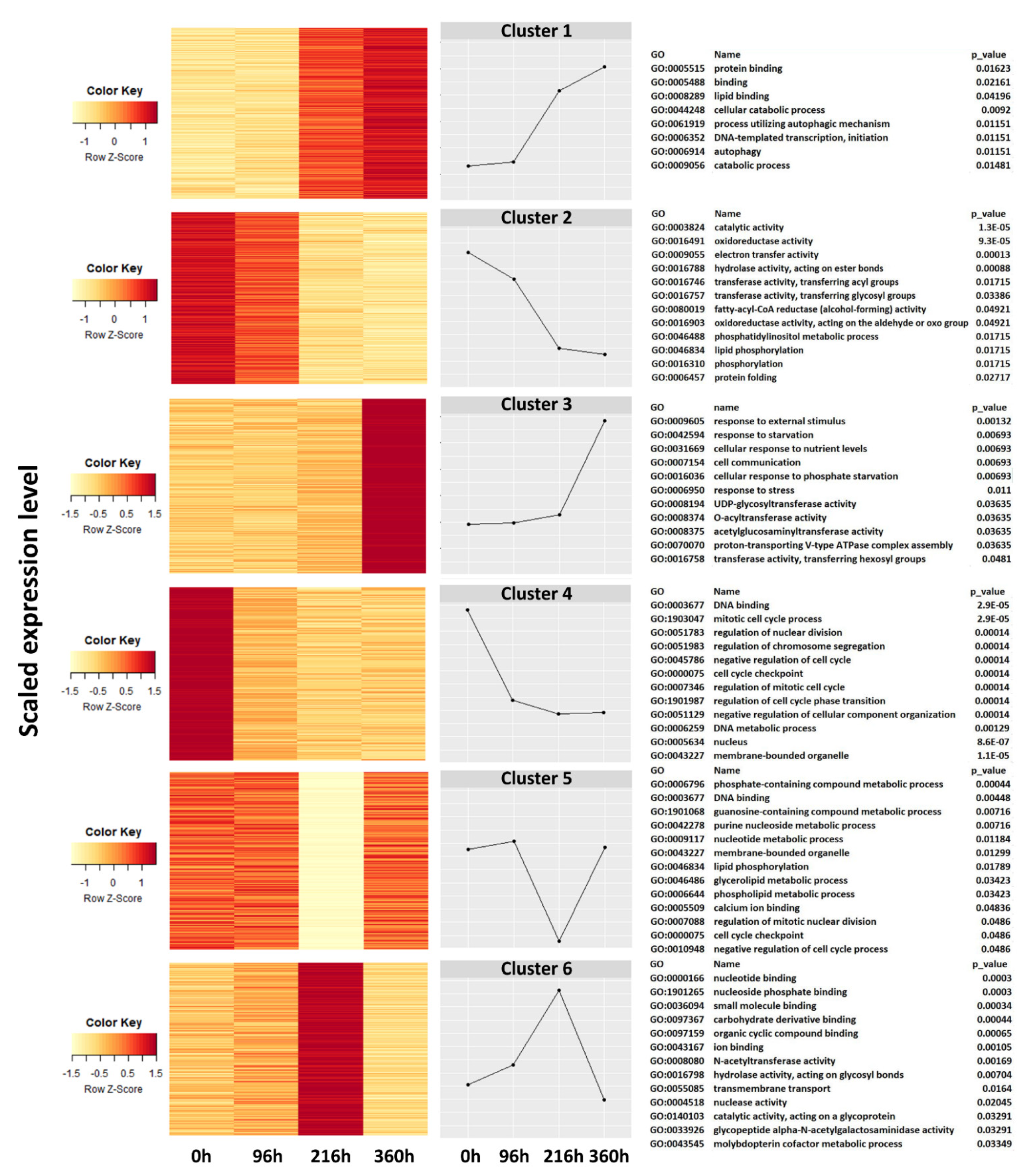
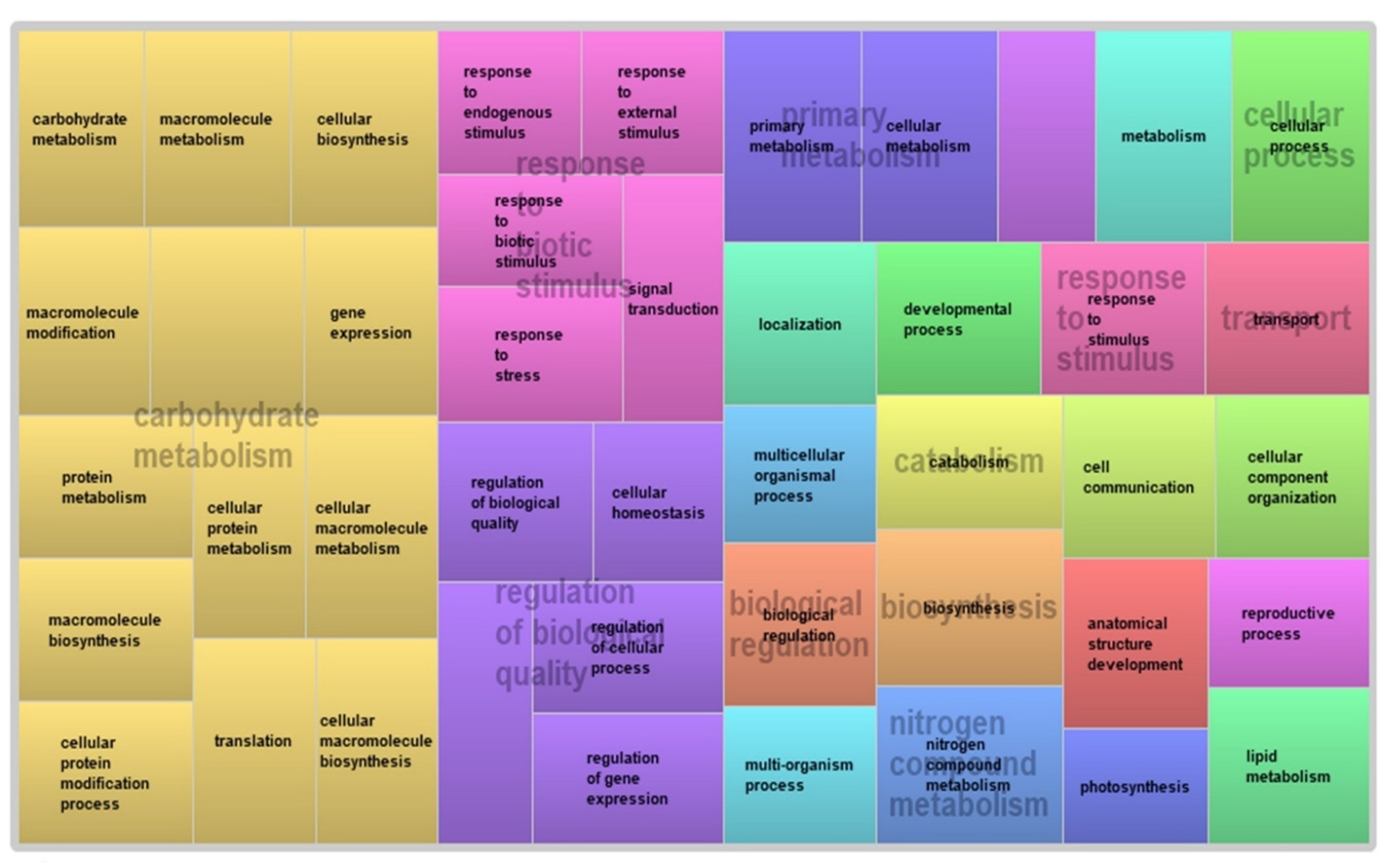
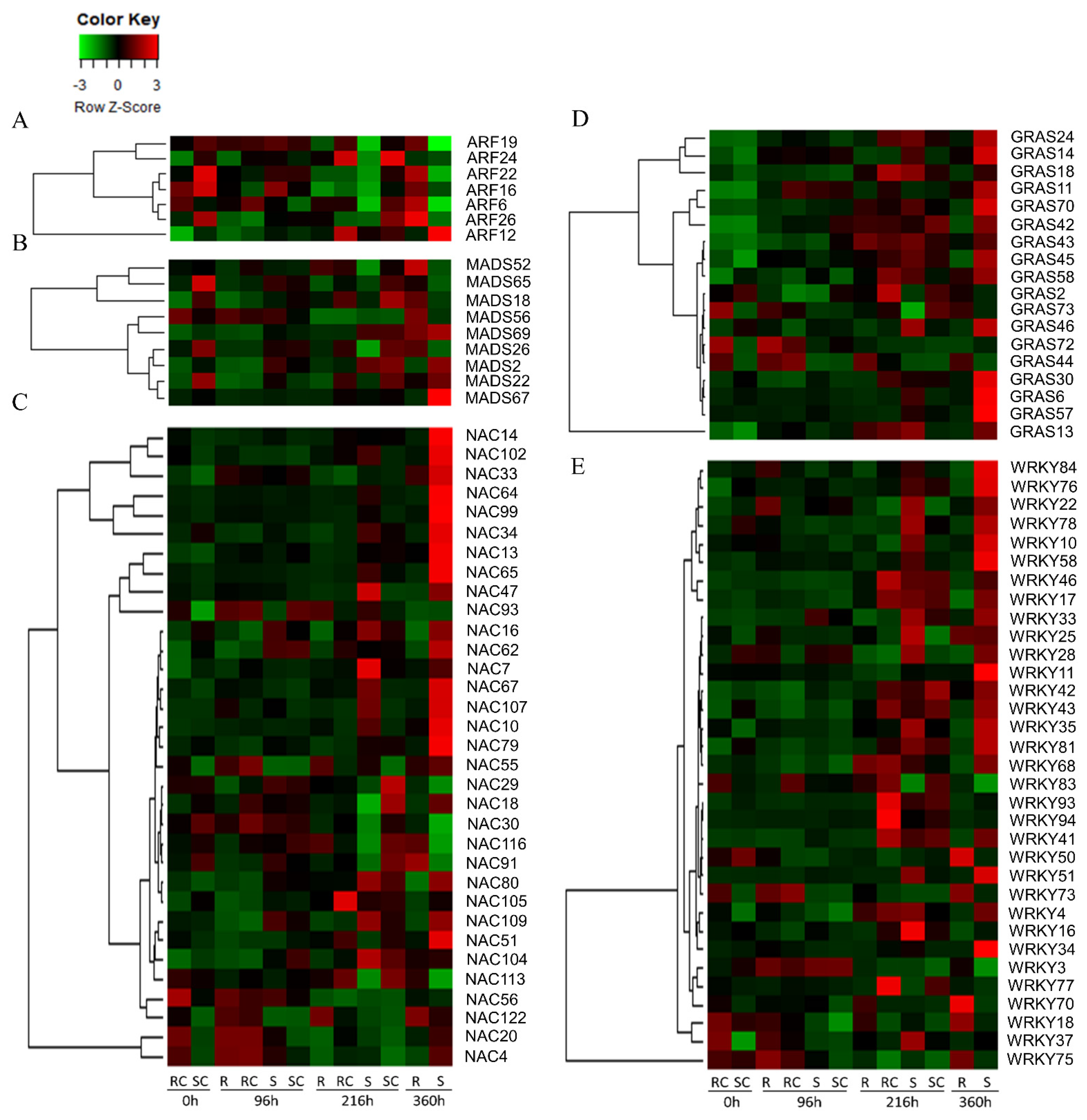
Publisher’s Note: MDPI stays neutral with regard to jurisdictional claims in published maps and institutional affiliations. |
© 2021 by the authors. Licensee MDPI, Basel, Switzerland. This article is an open access article distributed under the terms and conditions of the Creative Commons Attribution (CC BY) license (https://creativecommons.org/licenses/by/4.0/).
Share and Cite
Serba, D.D.; Meng, X.; Schnable, J.; Bashir, E.; Michaud, J.P.; Vara Prasad, P.V.; Perumal, R. Comparative Transcriptome Analysis Reveals Genetic Mechanisms of Sugarcane Aphid Resistance in Grain Sorghum. Int. J. Mol. Sci. 2021, 22, 7129. https://doi.org/10.3390/ijms22137129
Serba DD, Meng X, Schnable J, Bashir E, Michaud JP, Vara Prasad PV, Perumal R. Comparative Transcriptome Analysis Reveals Genetic Mechanisms of Sugarcane Aphid Resistance in Grain Sorghum. International Journal of Molecular Sciences. 2021; 22(13):7129. https://doi.org/10.3390/ijms22137129
Chicago/Turabian StyleSerba, Desalegn D., Xiaoxi Meng, James Schnable, Elfadil Bashir, J. P. Michaud, P. V. Vara Prasad, and Ramasamy Perumal. 2021. "Comparative Transcriptome Analysis Reveals Genetic Mechanisms of Sugarcane Aphid Resistance in Grain Sorghum" International Journal of Molecular Sciences 22, no. 13: 7129. https://doi.org/10.3390/ijms22137129
APA StyleSerba, D. D., Meng, X., Schnable, J., Bashir, E., Michaud, J. P., Vara Prasad, P. V., & Perumal, R. (2021). Comparative Transcriptome Analysis Reveals Genetic Mechanisms of Sugarcane Aphid Resistance in Grain Sorghum. International Journal of Molecular Sciences, 22(13), 7129. https://doi.org/10.3390/ijms22137129






